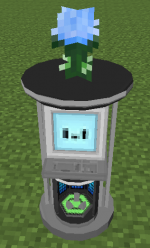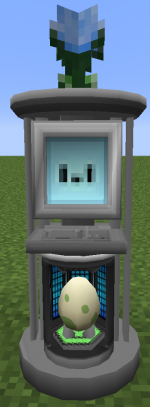Breeding/es
La crianza es un proceso en el cual dos Pokémon se reproducen, resultando un Pokémon nuevo de nivel 1.
Contents
Requisitos
En general, se necesitan dos Pokémon de géneros opuestos para la crianza. También deben ser parte del mismo grupo de huevo. Este procedimiento producirá un huevo que contendrá un Pokémon de nivel 1, el cual será la forma base evolutiva de la especie Pokémon de la madre (por ejemplo, una madre Venusaur producirá un huevo de Bulbasaur).
Excepciones
- Ditto puede reproducirse con cualquier Pokémon, excepto aquellos en el grupo de huevo desconocido. La compatibilidad no depende del género, por lo cual los Pokémon macho, hembra y sin género pueden reproducirse con Ditto. Esta es la única manera en que los Pokémon sin género pueden reproducirse.
- Si un Ditto se reproduce con otro Ditto, el huevo resultante será de una especie Pokémon al azar. Es posible encontrar Pokémon dentro de estos huevos que, normalmente, no podrían encontrarse, tales como Pokémon evolucionados. No obstante, Pokémon Legendarios no pueden ser eclosionados de estos huevos.
- Los Pokémon en el grupo de huevo desconocido no pueden reproducirse con ningún Pokémon, incluyendo a Ditto y otros Pokémon en su mismo grupo de huevo.
- Ciertos Pokémon, tales como Snorlax, no producirán sus formas base a no ser que la madre tenga equipado un determinado incienso. Sin el incienso, estos Pokémon producirán las formas evolutivas inmediatamente consecutivas a sus formas base (por ejemplo, criar con un Snorlax que no tenga equipado un incienso lento producirá un huevo que contenga otro Snorlax, en lugar de un Munchlax). Estos Pokémon y los inciensos requeridos se encuentran listados debajo:
- Chansey, Blissey→Happiny:
 Incienso duplo
Incienso duplo - Chimecho→Chingling:
 Incienso puro
Incienso puro - Mantine→Mantyke:
 Incienso acua
Incienso acua - Marill, Azumarill→Azurill:
 Incienso marino
Incienso marino - Mr. Mime→Mime Jr.:
 Incienso raro
Incienso raro - Roselia, Roserade→Budew:
 Incienso floral
Incienso floral - Snorlax→Munchlax:
 Incienso lento
Incienso lento - Sudowoodo→Bonsly:
 Incienso roca
Incienso roca - Wobbuffet→Wynaut:
 Incienso suave
Incienso suave
- Chansey, Blissey→Happiny:
- Si un Nidoran♀ se reproduce o un Nidoran♂, Nidorino, o Nidoking y un Ditto se reproducen, el huevo resultante puede contener tanto un Nidoran♀ como un Nidoran♂.
- Si un Illumise se reproduce o un Volbeat y un Ditto se reproducen, el huevo resultante puede contener tanto un Illumise como un Volbeat.
Comenzando
Para criar cualquier Pokémon, se requiere un PokéRancho.
Tras colocar un PokéRancho, dos Pokémon de la PC del jugador (no de su equipo) pueden ser colocados en su interior, donde empezarán a vagar dentro de un área de 9x9 alrededor del PokéRancho. Si estos Pokémon son compatibles para la crianza, el proceso de reproducción comenzará. Antes de la versión 7.0.0, el PokéRancho podía albergar hasta seis Pokémon y podían ocurrir múltiples procesos de crianza de forma simultánea dentro del PokéRancho, de ser compatibles los pares de Pokémon en su interior.
Proceso de crianza
Para que dos Pokémon compatibles se reproduzcan, primero deben amarse mutuamente. Para que esto suceda, el hábitat a su alrededor (dentro del rango del PokéRancho) debe ser apropiado para ellos, lo cual puede lograrse si hay una cantidad suficiente de bloques que sean aptos para los tipos de los Pokémon. Esto no depende del bioma. De no haber suficientes bloques apropiados para que ambos padres estén satisfechos, el proceso de crianza no podrá ocurrir.
Con Pokémon que tengan dos tipos, los bloques correspondientes a cualquiera de los tipos del Pokémon contribuirán a su satisfacción con el hábitat, pero cada bloque contribuirá individualmente menos que si fuera un Pokémo con un solo tipo. En la mayoría de los casos, bloques más raros contribuirán más a la satisfacción del Pokémon que bloques que sean más comunes.
Por cada area de 1x1, los PokéRanchos considerarán el bloque de mayor altura, en un máximo de tres bloques de altura respecto al PokéRancho.
Para hacer más fácil la construcción de un hábitat apropiado para la crianza, es posible colocar el PokéRancho en un bioma que ya contenga bloques aptos para el Pokémon que se reproducirá, pero esto no es necesario. El rango del PokéRancho también puede ser aumentado utilizando mejoras del PokéRancho (obtenidas como recompensas especiales), para así poder aumentar el número de bloques que se consideran en el hábitat. El rango máximo de un PokéRancho es de 15x15, siendo necesarias doce mejores del PokéRancho para alcanzarlo.
Para una explicación más detallada sobre cómo se determina la satisfacción con el hábitat y una lista completa de los bloques que son apropiados para cada tipo, revisa esta página.
Una vez que los Pokémon se encuentren satisfechos con su hábitat, comenzarán automáticamente a acumular afecto el uno por el otro. El progreso de su afecto puede ser estimado de forma aproximada por el color de los corazones que emanan del Pokémon, siendo los rojos aquellos requeridos para producir huevos.
| Nivel | Color del corazón |
|---|---|
| 0 | Sin corazones |
| 1 | |
| 2 | |
| 3 | |
| 4 | |
| 5 |
Mientras más bloques apropiados haya en el rango del PokéRancho, los Pokémon acumularán afecto el uno por el otro de forma más rápida. Un indicador general de cuan apropiado es un hábitat para cierto Pokémon puede verse al interactuar con el Pokémon. Los mensajes que se muestran al hacerlo se encuentran listados a continuación.
| Mensaje | Significado | Duración del proceso de crianza | Duración por cada etapa de la crianza |
|---|---|---|---|
| "¡Pokémon 1 no tiene a nadie para enamorarse!" | Sólo hay un Pokémon en el PokéRancho | N/A | N/A |
| "¡Pokémon 1 no se lleva bien con nadie!" | No hay otro Pokémon en el PokéRancho con el cual este Pokémon pueda reproducirse | N/A | N/A |
| "¡Pokémon 1 está loco por Pokémon 2, pero no se siente cómodo en este ambiente!" | Hábitat inadecuado. Pokémon que ya estén enamorados empezarán a perder afecto | N/A | -30 minutos (pierde afecto) |
| "¡A Pokemon 1 le gusta Pokémon 2 un poquito más cada día!" | Hábitat adecuado | 2 horas y 30 minutos | 30 minutos |
| "¡A Pokémon 1 le atrae Pokémon 2 algo más cada día!" | Hábitat adecuado | 1 hora y 15 minutos | 15 minutos |
| "¡El afecto entre Pokémon 1 y Pokémon 2 crece más cada día!" | Hábitat adecuado | 50 minutos | 10 minutos |
| "¡Pokémon 1 está perdidamente enamorado de Pokémon 2 cada día!" | Hábitat adecuado | 37 minutos y medio | 7 minutos y medio |
| "¡Pokémon 1 está enamorado de Pokémon 2 lo máximo posible!" | Los Pokémon han producido un huevo en el PokéRancho. | N/A | N/A |
También es posible avanzar de forma inmediata la etapa de crianza de los Pokémon utilizando un Reloj de arena plateado de Isi o un Reloj de arena dorado de Isi, los cuales pueden ser obtenidos como recompensas especiales. El proceso de crianza continuará incluso si el chunk no está cargado.
Cuando ambos Pokémon alcancen el máximo afecto, producirán un huevo, el cual será visible en el PokéRancho y podrá ser retirado dentro de su interfaz. El huevo será transferido al equipo del jugador o a su PC, dependiendo de si el equipo del jugador está lleno. A los dos Pokémon que produjeron el huevo se les restablecerá el afecto a 0 y el proceso de crianza iniciará nuevamente.
Si el PokéRancho es destruido en cualquier momento mientras un proceso de crianza esté sucediendo, todo el progreso se perderá, incluyendo el afecto de los Pokémon y las mejoras del PokéRancho utilizadas. Cualquier Pokémon que se encuentre en el interior del PokéRancho volverá a la PC del jugador.
Eclosionando
Tras reclamar un huevo, el jugador debe caminar con él hasta que eclosione. Un huevo no eclosionará ni estará cerca de hacerlo mientras esté guardado en la PC. En la pantalla resumen del huevo, en lugar de la información habitual, sólo hay un indicador aproximado de cuánto se demorará en eclosionar. Los huevos no pueden participar en combates.
Luego de haber dado una cantidad suficiente de pasos, el huevo eclosionará. Un "paso", en relación a la eclosión de huevos, es el equivalente al tiempo necesario para recorrer la distancia completa de dos bloques a una rapidez normal. Métodos que aumentan la rapidez al caminar, tales como montar un Pokémon, aumentarán la velocidad a la cual se descuentan los pasos restantes para la eclosión del huevo. La cantidad de pasos requeridos para que un huevo eclosione dependen de la especie del Pokémon que se halla en su interior y del valor del parámetro "stepsPerEggCycle" en el archivo config de Pixelmon.
Si en el equipo del jugador hay un Pokémon que tenga la habilidad Cuerpo llama o Escudo magma, cualquier huevo que se encuentre en el equipo del jugador eclosionará el doble de rápido. El efecto no se acumula si múltiples Pokémon del equipo tienen estas habilidades.
Una vez que el huevo eclosione, se revelará de su interior un Pokémon de nivel 1. El jugador podrá usar, entonces, el Pokémon recientemente eclosionado en combate y entrenarlo como si fuese un Pokémon común y corriente.
Herencia
Los padres pueden transmitir varios rasgos suyos a su descendencia.
IVs
- Juntos, los dos padres le transmitirán tres IVs aleatorios a su descendencia. Estos IVs no se superpondrán entre sí (es decir, la madre y el padre no pueden pasar los dos el mismo IV).
- Ciertos objetos equipados pueden influir en los IVs heredados. Estoy objetos se encuentran detallados en su propia sección, más abajo.
Poké Ball
- Si dos Pokémon de la misma especie se reproducen (sin importar su forma), el huevo tendrá la misma probabilidad de heredar la Poké Ball de cualquiera de los dos padres. De otro modo, la Poké Ball en la que se encuentre la madre será transmitida a su descendencia a menos que la Poké Ball sea una Master Ball o una Gloria Ball.
- En la crianza de Pokémon sin género, si un Pokémon en la ranura derecha del PokéRancho tiene una Poké Ball heredable (cualquiera que no sea una Master Ball o una o una Gloria Ball), el huevo heredará la Poké Ball correspondiente. De otro modo, la descendencia heredaría la Poké Ball correspondiente al Pokémon en la ranura izquierda.
Growth
- The growths of offspring are inherited from their parents. Growth inheritance is determined by the growth between the mother's and father's growths (e.g., ordinary is directly between runt and giant), with some random variance allowing the two growths directly next to the determined growth (using the previous example, small and huge growths would be possible as well). This slight variance in growth will occur even if both parents have the same growth. This is the only way to obtain Pokémon that are microscopic or ginormous, requiring two Pokémon that are pygmy or two Pokémon that are enormous (respectively) to breed together. Each offspring from these Pokémon will having a ⅓ chance of inheriting the corresponding extreme growth stats.
Ability
- The mother has an 80% chance of passing her Ability to her offspring, unless it's a hidden ability, in which case it will have a 60% chance to be passed to her offspring. The male's Ability has no bearing on the inherited Ability if a mother is present.
- If a male Pokémon breeds with a Ditto, the male Pokémon's Ability has a 60% chance of being passed on. This applies to normal abilities as well as hidden abilities. The Ditto's Ability does not affect this chance.
The 1150 chance (by default) of obtaining a hidden Ability is not present when breeding. If neither of the statements above allow the inheritance of a hidden Ability, there is no chance that the offspring will have hidden Abilities.
Note: The inheritance of Abilities depends entirely on the Ability slot of the Pokémon rather than the Ability itself. If all Abilities are obtained legitimately and not edited with external NBT editing tools, this is not an issue, but improperly editing the Abilities of Pokémon without changing their Ability slots will cause breeding mechanics to use the original, unedited Ability when determining inheritance. More information can be found here.
Egg moves
If the mother or father have certain moves, their offspring could potentially inherit these moves despite not normally being able to learn them.
- If either the father or the mother (or both) know certain species-specific "Egg moves", their offspring will inherit these moves. The majority of these moves are unable to be learned by the Pokémon except with this method.
- If the father knows any moves that can be taught via TMs or HMs, the offspring will inherit these moves if they are able to normally learn these moves via TM/HM.
- If both the mother and father know moves that are in their offspring's level up movepool, the offspring will inherit these moves. This may cause the offspring to know moves that it would normally only be able to learn at higher levels.
If more than four moves fit the criteria above, the moves that the offspring will have are decided using the above list as a hierarchy; i.e., Egg moves have priority over the other criteria. If there are more than four potential Egg moves to be inherited, the mother's Egg moves are prioritized.
If a Pikachu or a Raichu breeds while holding a Light Ball, the offspring Pichu will know the move Volt Tackle regardless of whether the parents know the move.
Held items
Several held items influence aspects of the parent Pokémon that are passed to the offspring Pokémon.
 Destiny Knot: If held by either parent, five IVs will be passed from the parents to the offspring instead of three.
Destiny Knot: If held by either parent, five IVs will be passed from the parents to the offspring instead of three. Everstone: If held by a parent, the offspring's Nature will always match the nature of the parent holding the Everstone. If both parents are holding Everstones, the offspring will randomly inherit one of the parents' Natures.
Everstone: If held by a parent, the offspring's Nature will always match the nature of the parent holding the Everstone. If both parents are holding Everstones, the offspring will randomly inherit one of the parents' Natures.- Power items: If held by a parent, the offspring will always inherit the IV from that parent that corresponds to the power item. If the two parents are each holding a different power item, both of them will pass down their corresponding IVs. If both parents are holding the same type of power item, either one of them will be randomly chosen to pass on the corresponding IV.
| Stat | Power item |
|---|---|
| HP | |
| Attack | |
| Defense | |
| Special Attack | |
| Special Defense | |
| Speed |
Alolan Breeding
When breeding Alolan Pokémon, the chance of receiving an Alolan Pokémon depends on its parents.
- If the parents are both Alolan, the egg will be Alolan 100% of the time.
- If the parents are Alolan and normal form, and the mother is the Alolan, the egg will be Alolan 50% of the time.
- If the parents are an Alolan and a Ditto, the egg will be Alolan 25% of the time.
- You can never breed a Pokemon you do not have. For example, you can not breed Alolan Vulpix and a regular Sandshrew to get an Alolan Sandshrew. It will only produce Vulpix, Alolan Vulpix, and regular Sandshrew.
Ability Breeding Alolan Pokemon
Breeding abilities with Alolans is different from normal ability breeding.
- An Alolan Pokemon can never pass down its ability or hidden ability if its child is not Alolan. Otherwise, it follows standard rules.
- A normal form Pokemon can never pass down its ability or hidden ability if its child is Alolan.
- Ditto can never pass down its ability to either form.
Other
- If the parents have differing original Trainers, their offspring have double the normal chance of being Shiny.
Config settings
- "allowBreeding": If this setting is set to false, ranch blocks cannot be crafted or placed, making breeding impossible.
- "allowRandomBreedingEggsToBeLegendary": This setting can allow two Ditto parents to potentially (randomly) produce Legendary Pokémon from their Eggs.
- "breedingTicks": How long it takes for a Pokémon to advance from one breeding level to the next under average conditions ("Pokémon 1 is more attracted to Pokémon 2 every day!"). This is measured in ticks (20 ticks = 1 second). If breeding environments are enabled, this time will be affected by multipliers depending on how suitable the breeding environment is.
- "numBreedingStages": The number of breeding levels required to produce an Egg.
- "stepsPerEggCycle": Egg cycles are used to determine how many steps it takes for Eggs to hatch. The lower this value, the fewer steps it takes for Eggs to hatch.
- "useBreedingEnvironment": Whether or not the environment around a ranch block affects the speed of the breeding process. If this is disabled, the speed of breeding will always be equal to "Pokémon 1 is more attracted to Pokémon 2 every day!"
Trivia
In earlier developmental versions of Pixelmon, the breeding process was different than the version that is currently in the mod. This antiquated version of breeding was never released publicly and was changed into the current version of breeding before the public release of breeding in Pixelmon.

 NodeCraft
NodeCraft















